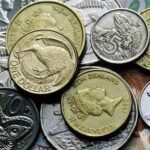 Australian dollar managed to distance from lows unseen in 3.5 years, but still remained lower against its US rival during the late phase of US session on Friday, following a set of overall positive data from the United States.
Australian dollar managed to distance from lows unseen in 3.5 years, but still remained lower against its US rival during the late phase of US session on Friday, following a set of overall positive data from the United States.
AUD/USD plunged to a daily low at 0.8694 at 13:45 GMT, after which the pair closed at 0.8752 on Friday, falling 0.50% for the day. For the week, however, the cross gained 0.79%. Support was likely to be received at July 20th 2010 low, 0.8684, while resistance was to be encountered at Fridays session high, 0.8824.
According to data by Thomson Reuters in cooperation with the University of Michigan, released on Friday, their gauge of consumer confidence for the United States came in at a final reading of 81.2 in January, which outstripped expertsexpectations pointing to a value of 81.0 and also the preliminary reading of 80.4, released on January 17th. The final value of the index of consumer sentiment stood at 82.5 in December.
Weaker rate of increase in nations employment probably continued to cause a certain pressure on consumers.
This indicator is closely watched by analysts and traders, as it provides clues on the development of consumer spending, which on the other hand, is a key component of US Gross Domestic Product.
Also yesterday, it became clear that US consumers spent considerably on goods and services in December. During the holiday season personal spending rose 0.4% compared to November, outpacing preliminary estimates of a 0.2% increase. This appears to be the most significant gain since the beginning of 2012. The pace of personal spending in November has been revised up to a 0.6% gain from a 0.5% gain previously.
During the whole 2013 US consumers have increased their spending by 3.1% in comparison with the whole previous year, or the weakest annual increase since 2009. However, personal spending has demonstrated a steady pace of increase during the second half of 2013.
Personal income in the United States remained flat in December compared to a month ago, following a 0.2% gain in November.
The Employment cost index (ECI) in the country rose 0.5% during the last quarter of 2013 compared to the preceding quarter, after in Q3 compared to Q2 the index climbed 0.4%.
Demand for the US dollar continued to be underpinned after the Federal Open Market Committee (FOMC) announced on Wednesday that it plans to reduce the pace of its monthly asset purchases to 65 billion USD from the current 75 billion USD. The Committee cited improvements in nations labor market and the pace of US economic growth, which has begun to accelerate in recent quarters. The central bank is to gradually withdraw from its unprecedented accommodative monetary policy and exit the easing program by the end of this year.
Meanwhile, traders saw a 95% probability that the Reserve Bank of Australia (RBA) will maintain its benchmark interest rate at the current all-time low level of 2.50% at its policy meeting scheduled next week, swaps data by Bloomberg showed.
The yield on Australian benchmark 10-year bonds dropped 1 basis point, or 0.01 percentage point, to reach 3.99% on Friday, or the lowest level since October 30th.
At the same time, a report by the RBA stated that private sector credit in Australia rose 3.9% in December compared to a year earlier, which exceeded preliminary estimates of a 3.7% gain. In monthly terms, private sector lending climbed 0.5% in December, following a 0.3% gain in November.
Commonwealth Bank of Australia, the biggest lender in the country, revised down its forecast regarding the exchange rate of the Aussie to 84 U.S. cents by the end of the year from the previous forecast of 89 U.S. cents.
Elsewhere, having touched a daily high at 1.5588 at 11:30 GMT, EUR/AUD cross closed at 1.5412 on Friday, ticking up a mere 0.01% for the day. However, the pair registered a 2.16% weekly drop.





